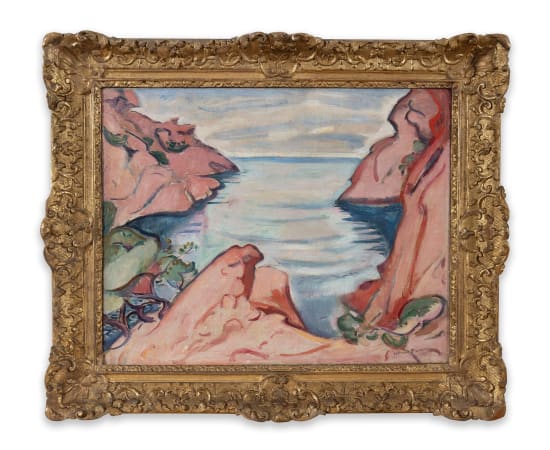Achille-Émile Othon Friesz (1879-1949) French
Works
Video
Biography
Born in the port city of Le Havre, Othon Friesz emerged as a powerful and independent voice in the early 20th-century French avant-garde. A close contemporary and lifelong friend of Georges Braque, Friesz shared formative years at the École des Beaux-Arts in Paris, where academic rigor laid the foundation for his later stylistic evolution. Though drawn early to Impressionism, it was the radical freedom of Fauvism that ignited Friesz’s creative spirit—prompting a bold and brief embrace of high color and expressive form that left an indelible mark on his artistic identity.
By 1906, Friesz was exhibiting alongside Matisse, Derain, and Vlaminck, contributing to the fiery emergence of Fauvism. His canvases from this period pulse with liberated brushwork, Mediterranean vibrancy, and a structural sense that grounded even his most exuberant compositions. Yet, unlike some of his Fauvist peers, Friesz gradually returned to a more restrained approach, seeking to reconcile modern color with classical order. He considered himself, above all, a builder—a painter who constructed form and space with clarity, rhythm, and a deep respect for tradition.
Friesz’s travels—to Italy, Belgium, and the south of France—further deepened his appreciation for Renaissance harmony and Baroque movement, influences that permeate his work across genres: landscapes, still lifes, nudes, and portraits. Throughout the interwar period, Friesz developed a personal idiom that resisted categorization—modern yet rooted, emotional yet controlled.
His career was marked by continued success and recognition. He exhibited at the Salon d’Automne and the Salon des Indépendants, later becoming a professor at the École des Beaux-Arts, where his influence shaped a new generation of painters. Today, his works reside in major collections, including the Centre Pompidou (Paris), the Musée d’Art Moderne de la Ville de Paris, Tate (London), and The Museum of Modern Art (New York).
At Bailly Gallery, Friesz finds a fitting home—a space where his vision is appreciated not merely for its historical importance, but for its enduring artistic resonance. His work speaks to collectors and connoisseurs who value the rare balance of innovation and reverence, spontaneity and structure. Friesz is not only a painter of color and form, but a craftsman of visual intelligence—an artist who, in bridging classical legacy with modern urgency, defined a path uniquely his own.
By 1906, Friesz was exhibiting alongside Matisse, Derain, and Vlaminck, contributing to the fiery emergence of Fauvism. His canvases from this period pulse with liberated brushwork, Mediterranean vibrancy, and a structural sense that grounded even his most exuberant compositions. Yet, unlike some of his Fauvist peers, Friesz gradually returned to a more restrained approach, seeking to reconcile modern color with classical order. He considered himself, above all, a builder—a painter who constructed form and space with clarity, rhythm, and a deep respect for tradition.
Friesz’s travels—to Italy, Belgium, and the south of France—further deepened his appreciation for Renaissance harmony and Baroque movement, influences that permeate his work across genres: landscapes, still lifes, nudes, and portraits. Throughout the interwar period, Friesz developed a personal idiom that resisted categorization—modern yet rooted, emotional yet controlled.
His career was marked by continued success and recognition. He exhibited at the Salon d’Automne and the Salon des Indépendants, later becoming a professor at the École des Beaux-Arts, where his influence shaped a new generation of painters. Today, his works reside in major collections, including the Centre Pompidou (Paris), the Musée d’Art Moderne de la Ville de Paris, Tate (London), and The Museum of Modern Art (New York).
At Bailly Gallery, Friesz finds a fitting home—a space where his vision is appreciated not merely for its historical importance, but for its enduring artistic resonance. His work speaks to collectors and connoisseurs who value the rare balance of innovation and reverence, spontaneity and structure. Friesz is not only a painter of color and form, but a craftsman of visual intelligence—an artist who, in bridging classical legacy with modern urgency, defined a path uniquely his own.
Enquire

